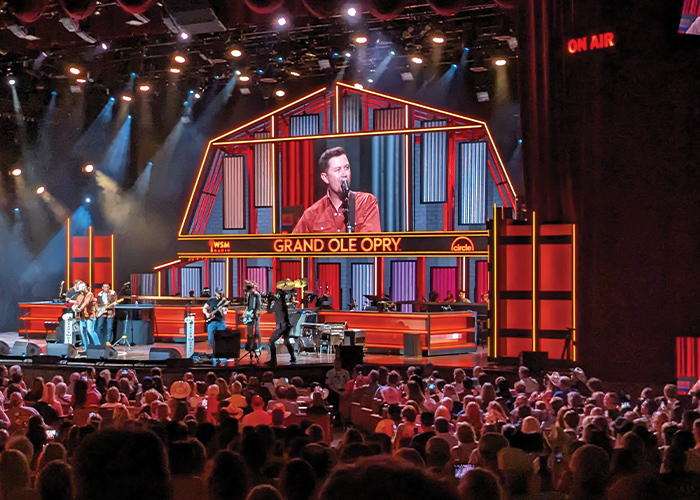When you think about Nashville, you can’t help thinking about the legendary Grand Ole Opry, the true home of country music. This iconic radio show, which began almost 100 years ago, continues to be the longest-lived and most popular showcase for country western music.
WSM Barn Show
The early origins and humble beginnings of the Grand Ole Opry can be traced back to 1925 and to another radio program called the "WSM Barn Dance,” which originated in Chicago. The show was aired from a radio studio located on the fifth floor of the National Life & Accident Insurance Company in downtown Nashville, whose founder convinced the company to launch its own radio station: WSM – named after their slogan “We Shield Millions.” What began as a simple radio show to help sell insurance transformed into the most famous radio show in history.
The Birth of the Grand Ole Opry
Over the next few years, the Nashville "Barn Dance" audience continued to grow, with thousands tuning in to hear the latest band or solo musician. The show aired on Saturday nights and featured folk music, fiddling, and the relatively new genre of country-western music. Showcasing this uniquely American style of music, the radio broadcast became a launching ground for many of the country’s most-loved performers.
In 1927, George D. Hay, the show’s announcer and program director, proclaimed on-air, "For the past hour we have been listening to the music taken largely from the Grand Opera, but from now on we will present the Grand Ole Opry.” This new name resonated with country music listeners and the rest is history.
The Ryman Auditorium Years
As the new name caught on, the size of the crowds for the weekly radio broadcast continued to grow. It wasn't long before a larger venue was needed. The program first moved to the Belcourt Theater, previously known as the Hillsboro Theater, then to The Dixie Tabernacle, next to the War Memorial Auditorium, and then eventually, in 1943, settled into the Ryman Auditorium, formally the Union Tabernacle. The Grand Ole Opry would make Ryman its home for the next three decades.
Here, some of the Grand Ole Opry’s most memorable moments happened: Hank Williams made his debut. Johnny Cash became a member, met his wife, and during one infamous show, broke all of the footlights at the front of the stage. Patsy Cline, Loretta Lynn, Willie Nelson, and Dolly Parton joined the Opry family and Elvis Presley made his only Opry appearance here.
On March 15, 1974, The Opry broadcasted its last Friday show from the Ryman. The now-legendary radio show moved out of the Ryman Auditorium to set up residence in a brand new building officially named the Grand Ole Opry House.

Live From Opry House
The new 4,440 seat Opry House gave the show more space and the facilities needed to evolve, featuring an elegant stage, state-of-the-art sound and lighting systems, and a spacious backstage area. The move to the new facility allowed the Grand Ole Opry to expand its programming and bring in more high-profile performers.
In tribute to its roots at the Ryman, a 6-foot wooden section of the old stage was cut out and placed at the center of the new stage. The pew-style seating remained, a subtle nod to what was found in the Ryman Auditorium, conveying the sense of community that has always been at the core of the show.
The first performance in the new venue, on March 16th, 1974, featured a performance of "The Wabash Cannonball,” by Roy Acuff, as well as several performances by Opry members, including Stonewall Jackson, Minnie Pearl, and Dolly Parton, among others. President Richard Nixon was also in attendance and led the Opry audience in singing "Happy Birthday" to First Lady Pat Nixon.
The Fate of The Opry
It was unknown what fate would befall "The Grand Ole Opry, " when in 1982, American General insurance company took over National Life and its properties and the Opry's new owner began to negotiate the sale of some of National Life's assets.
Hearing of this, an Oklahoma businessman, by the name of Ed Gaylord and good friend of country music legend Minnie Pearl, bought the properties and vowed to continue operations of the Grand Ole Opry House and the "Grand Ole Opry" radio program.
The Legacy Lives On
The Opry is still owned by Gaylord Entertainment and continues to evolve and improve to meet the needs of the 21st century. Every Saturday evening, listeners from around the world can still tune into the live broadcast and thousands can also still travel to the Grand Ole Opry House to hear legends of country music or to catch a rising star as they get their big break.
Visit the Grand Ole Opry and so much more on our Music Cities cruise, Tennessee Rivers cruise, or our Great Smoky Mountains National Park itinerary. You can also view our complete list of Mississippi River cruise itineraries before booking.


